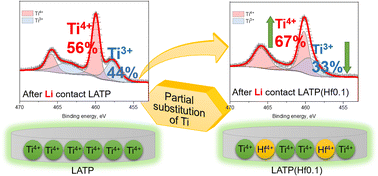All-solid-state Li-ion batteries (LIBs) with a solid electrolyte instead of a liquid one demonstrate significantly higher safety in contrast with the conventional liquid-based LIBs. An inorganic NASICON-type Li conductor Li1.3Al0.3Ti1.7(PO4)3 (LATP) is a promising solid electrolyte with an ionic conductivity of up to 10−3 S cm−1 at room temperature. However, LATP gradually degrades in contact with Li metal because of reduction of Ti4+ to Ti3+, resulting in a lower ionic conductivity at the electrolyte–electrode interface. Cation doping is a promising approach to stabilize the LATP structure and mitigate the Ti reduction. Here, we report our findings on the alternative polycationic doping strategy of the LiTi2(PO4)3 (LTP) structure, when a heterovalent cation is added along with Al. In particular, we studied the effect of tetravalent and divalent cation dopants (Zr, Hf, Ca, Mg, Sr) of LATP on the Li-ion conduction and Ti reduction during interaction with lithium metal. The samples were prepared by molten flux and solid-state reaction methods. The structure, morphology, and ion-transport properties of the samples were analyzed. The activation energy of Li-ion migration in all synthesized systems was calculated based on the electrochemical impedance spectroscopy (EIS) data retrieved for a temperature range of 25–100 °C. From the obtained results, the tetravalent doping (Zr4+ and Hf4+) appeared to be a more promissing route to improve the LATP electrolyte than the divalent doping (Mg2+, Ca2+, and Sr2+). The X-ray photoelectron spectroscopy analysis of the samples after their contact with lithium provided the data, which could shed light on the effect of the incorporated dopants onto the Ti reduction.

